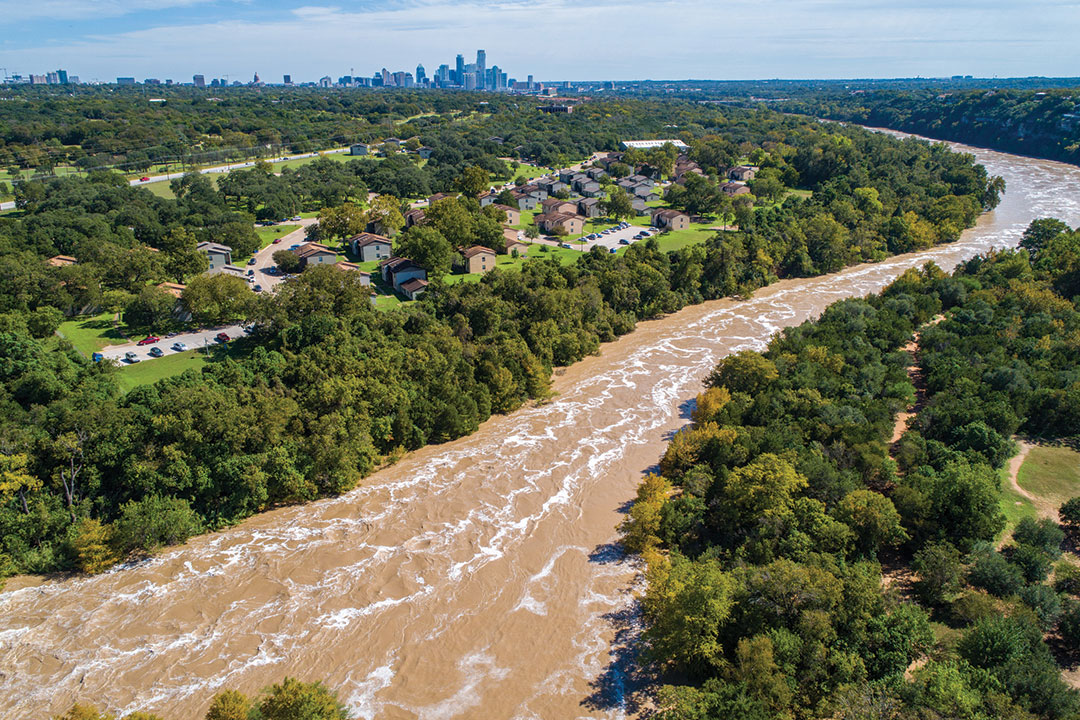When catastrophic flooding struck Texas during the July 4th weekend in 2025, helicopter flood rescues proved indispensable. Entire neighborhoods were submerged, roads were blocked, and communication systems failed, leaving helicopters as the only way to reach those trapped. U.S. Coast Guard, state, and local emergency teams performed countless aerial rescues, pulling stranded residents to safety under dangerous conditions.
Record Rainfall and Widespread Damage

view from high above Colorado River and Red Bud Isle Flood waters with Austin , Texas skyline in the far distance
A stalled storm system dumped up to 20 inches of rain in 48 hours across southeast Texas. Flash floods overwhelmed rivers, drainage systems, and emergency response teams. Harris, Liberty, and Montgomery counties saw massive flooding, forcing residents to evacuate or wait for rescue from rooftops and vehicles.
At least 18 deaths were confirmed by July 7, with hundreds of rescues statewide. Emergency crews called it one of Texas’ worst floods, rivaling disasters like Hurricane Harvey in 2017.
Helicopters as Lifelines in Search and Rescue
As floodwaters rose and emergency calls surged, multiple agencies deployed helicopters. The U.S. Coast Guard, Texas Military Department, and local law enforcement used rotorcraft for vertical lifts, hoist rescues, and aerial surveys. Often, helicopters were the sole means of reaching victims with no other escape options.
Yahoo News and People Magazine shared gripping footage of aircrews hoisting people from trees, flooded buildings, and swift currents. One video showed a Coast Guard MH-65 Dolphin crew saving a family, including a child and pet, amid poor visibility and turbulent winds.
Key Helicopter Models in Action

Airbus H145 (formerly Eurocopter EC145) | Photo: airbus.com
Several helicopter types were critical to the effort:
- Sikorsky MH-60 Jayhawk: The Coast Guard’s choice for long-range search and rescue.
- Eurocopter EC145: Used by state teams for urban rescues.
- Bell 412 and UH-60 Black Hawk: National Guard aircraft for wide-area response.
These helicopters had winches, night vision systems, and rescue baskets to operate in flooded areas and harsh weather.
Coordinated Aerial Response
FEMA, the Texas Division of Emergency Management, and the National Guard managed flight operations using aerial maps, drone footage, and survivor location data. Helicopters not only rescued people but also helped spot levee breaches and deliver rescue swimmers to remote spots.
Responders established flight corridors for multiple agencies and ran continuous missions for full coverage. Helicopters also airdropped supplies like water, blankets, and radios to those awaiting help.
Public Praise and Heroic Efforts

Rear view of paramedic against landing helicopter of emergency medical service.
Aerial rescues drew widespread admiration. Social media buzzed with videos of daring saves, with many praising the bravery of pilots, crew, and rescue swimmers. FOX 7 Austin highlighted a Coast Guard crew saving over a dozen people from a flooded apartment complex despite high winds and poor visibility.
Texas Governor Greg Abbott commended rescue teams, saying,
“Their speed, skill, and courage saved hundreds. We owe them our thanks.”
Obstacles and Key Takeaways
Despite successes, the response faced challenges. Limited night-capable aircraft, weather delays, and communication breakdowns slowed operations. These issues underscored the need for better emergency aviation resources.
Experts also stressed using drones for quick assessments and communication support alongside helicopters for heavy lifting and rescues.
A Sobering Legacy: What the 2025 Rescues Teach Us
The 2025 July 4th weekend floods in Texas highlighted the escalating danger of extreme weather. Helicopter flood rescues became a lifeline, bypassing obstacles to save lives and deliver hope from above.
As climate disasters grow more frequent, helicopters will remain vital in disaster response. Investing in better coordination, equipment, and training will ensure aerial rescues can meet future challenges head-on.
